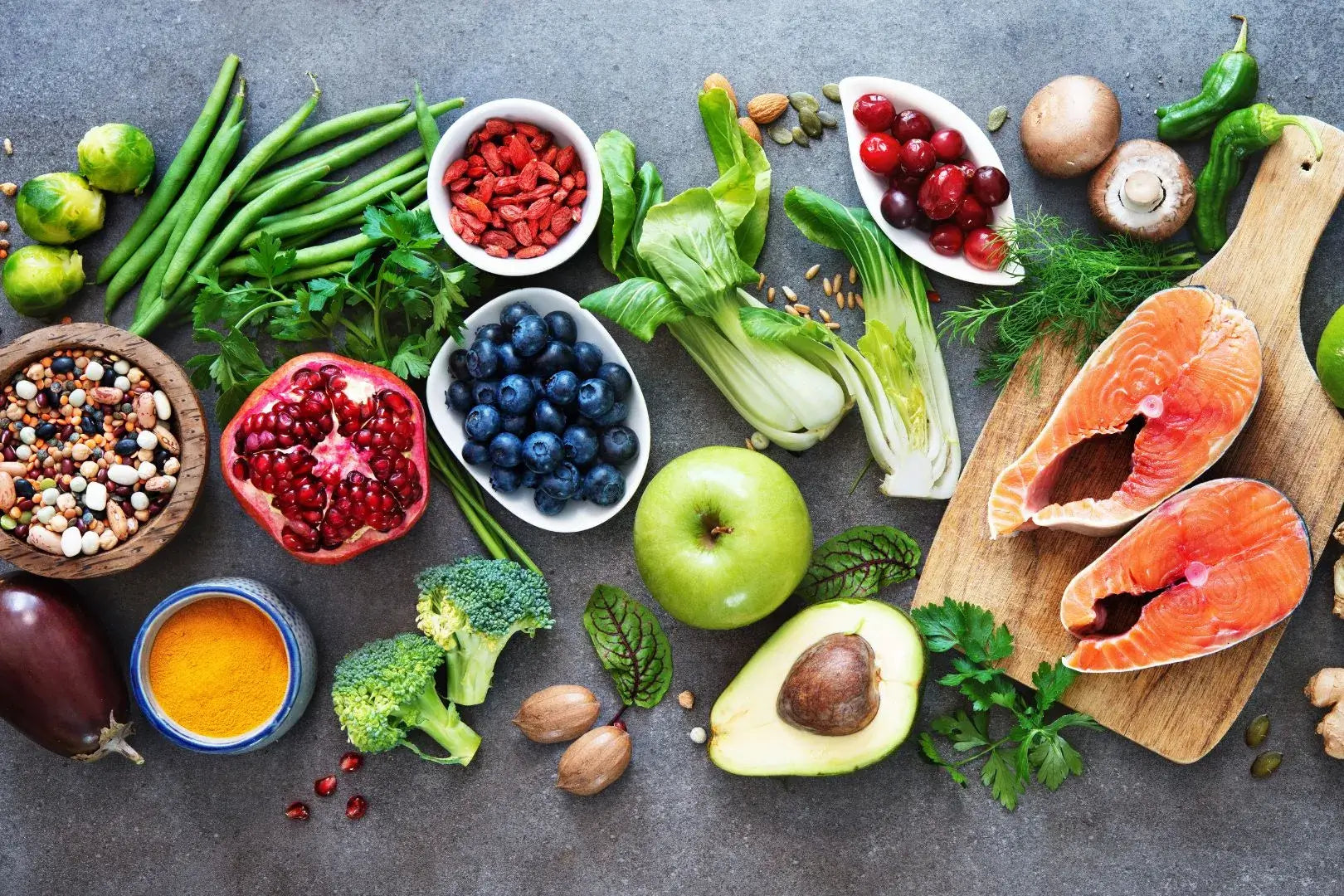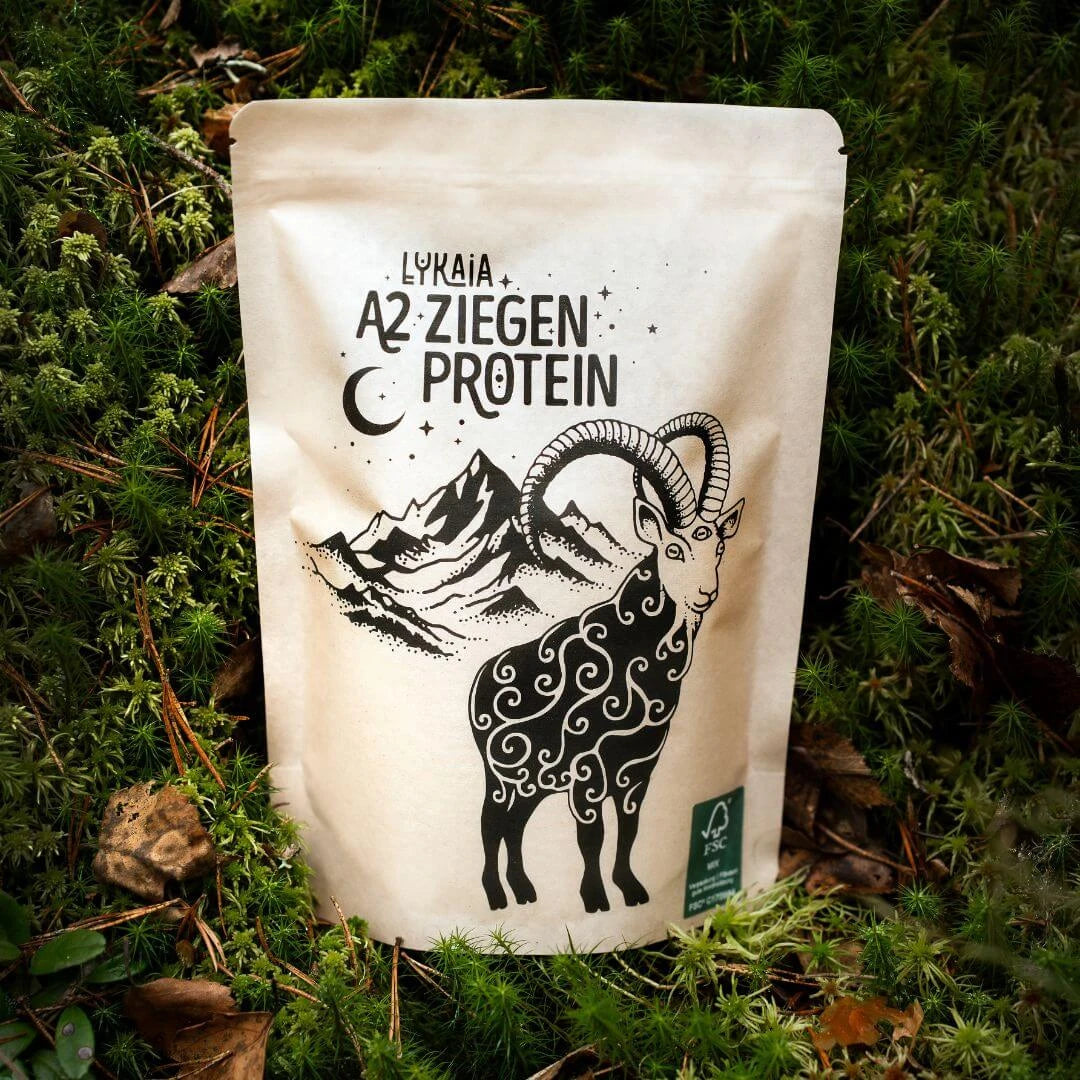Healthy eating - 9 tips to make it easier for you

written by Robin Dören
Do you want to eat healthier, but are overwhelmed? You just can't find the time between everyday family life and work? In this article we will show you a very simple way to get started with a healthy diet that doesn't take much more time and doesn't have to cost much more. Even though we think that nutrition should be the last thing you save on!
To give yourself the motivation you need away from Instagram fitness models, you should keep the following in mind:
The most complex organism in the universe
As long as we haven't discovered aliens, the human body is the most complex organism in the universe. No engineer, biologist, doctor or chemist can decipher it completely.
For most illnesses and injuries, the go-to method of medicine is to support the body in healing itself as best as possible. A broken arm is set and put in a cast and 6 weeks later it is simply healed again, as if by magic.
An illness like the flu is left to the immune system and in most cases it gets rid of the virus after 1-2 weeks.
We live in a complex machine that we shouldn't throw a wrench into if possible. We should keep her well-oiled and give her everything to make things run smoothly. Because this machine has only one priority: keeping you alive using all available means.
With this background it should be easier for you to make the right decisions in the supermarket.
But what do they look like?
Roughly speaking: You can choose a cola or a homemade kale smoothie. One product shortens your life in the long run, the other prolongs it. How can it be that Cola is one of the most popular drinks in the world?
The answer is simple. It’s called “short-term gratification.” As I mentioned earlier, our bodies do everything they can to keep us alive. Unfortunately, he doesn't think about the long-term consequences and that means that he wants to save maximum energy and puts you in a state of intoxication when consuming a high-calorie food, such as cola. To ensure survival in the harsh nature, there is nothing better than consuming as many calories as possible in the shortest possible time.
Unfortunately, due to the conveniences of modern society, this turns into the opposite: constant access to this type of food makes us sick and shortens our lives.
Take care of your molecular machines
The entire experience you call “life,” your perception of the world, and your hopefully everyday state of health are the result of countless molecular machines working for you around the clock. This becomes really clear when you look at scientific animations of your own biochemistry in the body:

For example, your DNA is constantly being read here.

And here is a sequence of constantly occurring cell division.
Looks like a busy warehouse right?
When you're really sick, you really notice how your body works. Suddenly everything feels like a dream, you can only lie down and every movement feels 10 times harder. The same molecular machines that control our perception and everyday activities like digestion are now tasked with fighting the invaders. Every energy reserve is used to get the invaders out of the system as quickly as possible.
Now the limbic system takes control and you suddenly realize how much you are at the mercy of your body. Suddenly you have chills to raise your body temperature. Your brain feels foggy, you're not really yourself anymore.
The limbic system is stimulated by messenger substances from the immune system that are released during immunological defense reactions. They trigger behavior that supports recovery and healing, the so-called “sickness behavior”. That's why when you're sick you just lie in bed, no longer have any appetite and become sleepy. By the way, this is very similar with depression. There, too, the body switches to illness behavior.
Similar to a good film in which you forget that a camera is running, in a healthy body you hardly notice anything of the "behind the scenes", i.e. what is going on behind the curtain. Only when something goes out of order do you want your health back.
Why am I telling you all this?
When you realize that you live in a miracle of nature, you will find it easier to muster the willpower to make certain decisions.
Healthy eating starts in the supermarket
Of course, food manufacturers don't sleep, but use every marketing tool to convince you of their products. Suddenly it says “high protein” everywhere, in Kinder Country there are “important cereals” and fish fingers are now also available with “healthy” whole grain breading.You should first get into the habit of looking at the ingredients list of every product you buy in the supermarket.
The resulting frustration led us to place our list of ingredients frontally and presently on the packaging:

Your products don’t even have a list of ingredients? Then you are doing everything right!
Because that means that you buy food as it comes from nature. In other words: potatoes, rice, eggs, natural vegetables, basic foods.
Reading the ingredients when shopping for your groceries will take a little more time at first, but after a few times you'll quickly realize what you can and can't buy. You'll be surprised at how many of your current foods unfortunately really don't deserve the label "healthy".
Be patient, your taste buds will adapt over time!
Maybe at first you will say that you don't like healthy food. This will be difficult for you at first, especially if you are very used to sugary foods. Sugar can be so addictive that giving it up can almost be compared to drug withdrawal.
But your taste buds adapt pretty quickly and soon you'll be enjoying tasting real food again. The best way to stay strong and not give in during the adjustment phase is to avoid having unhealthy foods in the house in the first place.
It starts with the right purchase!
However, most families have the infamous candy drawer. One family member now wants to eat healthily, but if the rest don't follow suit and temptation is always at hand, it becomes very, very difficult.
So: Talk to your family or your life partner! Try to convince her by all means that there will be less sweets in the house from now on. Or, ideally, none at all during the adjustment phase.
Often it is the life partner who does not want to change his diet at all. Or the kids who only eat pizza and fries. Or the misconception that you can have hypoglycemia without regularly eating chocolate. When I used to have circulatory problems, my mother's first reaction was to give me a bottle of Coke.
These are all effects of ignorance about your own body.
I would like to apologize in advance to my family for the following paragraph, because I know they will read this:
But nothing has taught me as much about the psychological aspects of healthy eating as my own family and my attempts to guide them into better eating habits.
It wasn't easy at first.
If I said that fish was healthy, there was a gourmet fillet from Iglo in the freezer the next day. When I said that yogurt was healthy, there was sweetened fruit yogurt in the fridge. Cheap vegetable oil is bad, but Rama's artificial substitute was almost certainly even worse.
But these rookie mistakes opened my eyes to the typical traps you find in the supermarket. Unfortunately, here in Germany we have drawn the A card in this regard:
It feels like 80% of the usual food in German supermarkets is “junk”!
Anyone who has ever strolled through a Finnish or Dutch supermarket with their eyes open will wonder what is going wrong with us. All the tips that I give you throughout the article are much easier to implement here. The proportion of foods with a clean list of ingredients is really excellent there.
Even products that can only be found for a lot of money and with luck in health food stores are widely available there and correspondingly cheap. The Netherlands in particular is the absolute leader here, with the city of Wageningen also known as the Silicon Valley of the food industry.
Why is there no marketing for kale?
Everything that is promised to you in advertisements can be achieved with a healthy diet and appropriate exercise: whether a longer life, more beautiful skin, more beautiful hair, supple joints, joy of life and absolute health. With all of these things, simple decisions in the supermarket are half the battle. Better sleep, better blood circulation, better memory, name me your complaint and 90% of the time it can be eliminated or at least reduced with the right diet and exercise.
Healthy Eating: Simple Do's and Don'ts for the Supermarket
Fish is healthy - the gourmet fillet from Iglo with 5 additives and an inferior breading but not so much. Sardines in olive oil or sockeye wild salmon are our favorites because these types of fish are the least contaminated with heavy metals. Wild salmon from the Salmo Salar brand is also okay. Definitely prefer wild salmon over farmed salmon because it is significantly less contaminated and comes from natural sources. You can also recognize this by its red-orange color.
Another tip for the sake of the environment: Try to avoid net-caught fish. However, this is also a challenge from a cost perspective and is hardly feasible in a normal supermarket.
Pickled cucumbers are great - but the list of ingredients should be clean: there is often added sugar or various food additives. Our recommendation: Simple salt-dill pickles with only 4 ingredients: salt, dill, cucumbers and herbs. It often says “no added sugar” on it. By the way: Just a tiny sip of cucumber water is full of healthy bacteria that help your intestinal flora.

Here you actually see the same product but 2 different lists of ingredients.
Above is the healthy version of pickled cucumbers: unsweetened salt dill cucumbers with 4 simple natural ingredients.
Below is the unhealthy version with glucose-fructose syrup & sugar.
Kefir and yoghurt are considered superfoods for the intestines: but please without fruit jellies, flavors and added sugar. Best: ferment it yourself! If you want flavor, add fresh fruit, honey or berries.

Also with yoghurt: the healthy version at the top and the unhealthy version with flavor at the bottom. Here sugar comes directly after yogurt in the list of ingredients. The ingredients are always arranged in order according to their quantity. So there is more added sugar in this than peaches or raspberries.
Does that make you fat? No and you won't die from it either, but it still trains your taste buds on sugar and when combined with other unhealthy foods the effect wears off at some point. You also want to consume yogurt for its healthy effect on the intestines. Unfortunately, the effect is canceled out by the added sugar.

Unfortunately, the popular protein puddings from the supermarket don't have much to do with health. There's just whipped cream in here. And foam preventers made from soybean oil. Deadly? No. Necessary? Neither.
Use vegan substitutes with caution: These products are often packed with additives to achieve a similar texture to their animal originals. It is rare to find “clean” vegan substitute products; you should always look at the list of ingredients. Even falafel can be made with low-quality vegetable oil and wheat flour.

Whole grain products are a great source of fiber but: The “whole grain fish sticks” from Iglo or the whole grain pizza are not the best choice due to the high fat content and additives.

Surprise! It actually says what it says: 100% whole grain rye flour and whole grain rye sourdough. No hidden wheat flour. However, there are deductions for the emulsifier, which is made from soybean oil.
Avoid breaded products: everyone knows and loves them. Whether crispy breaded chicken, fish or similar products. The problem is once again the manufacturers. The starting products for the breadings are often inferior, for example they are pre-fried in cheap vegetable oil and are full of unhealthy trans fatty acids. Baked goods are also a candidate for hidden unhealthy substances. Better: bread it yourself! Great breadings can be made with tapioca, arrowroot or buckwheat flour.
Avoid Cheap Vegetable Oil - I've already touched on this in the other points, but cheap vegetable oil is one of the biggest culprits. Make sure that your products contain olive oil, linseed oil, pumpkin seed oil, avocado oil, walnut oil or other high-quality fats. You can use olive oil or ghee for frying. Good grass-fed butter is also better than cheap vegetable oil.

If you look for sardines in the supermarket, 99% of the time you will find the type on the left: marinated in cheap sunflower oil. This takes the effect of the healthy fatty acids from the fish straight back into the cellar. The Nutri-Score failed here again across the board: both packs received a rating of “B”.
Good meat in moderation is one of the best foods - but that doesn't mean that the pressed patty in the €1 microwave burger is okay. Our recommendation: game meat from a hunter in the local forest. This hardly caused any CO2 and is priced in a high category, so you only get it maybe twice a month. The perfect frequency for meat consumption. If you want to avoid red meat, look for chicken from local farms in the health food store, for example.
There are many reasons for all these rules, one of the most important of which has to do with blood sugar response :
What exactly is blood sugar?
Blood sugar is the amount of glucose (a type of sugar) present in the bloodstream. Glucose is a source of energy for the body's cells and is particularly important for the proper functioning of the brain, muscles and other organs.When we eat carbohydrates (e.g. bread, pasta, fruit or sweets), our digestive system breaks them down into glucose, which enters the bloodstream. In response to the increase in blood sugar levels, the pancreas releases the hormone insulin, which ensures that glucose gets into the body's cells, where it can be used as energy or stored for later use.
The amount of glucose in the blood is regulated by a complex interaction of hormones, including insulin and glucagon, as well as other factors such as physical activity, stress and medications. Abnormal blood sugar levels can indicate various health conditions, such as: B. on diabetes, hypoglycemia (low blood sugar) or hyperglycemia (high blood sugar). Monitoring blood sugar levels is important for diabetics because it can help you adjust your diet, medications, or lifestyle to optimally control blood sugar and avoid cravings.
What does a healthy blood sugar response look like?

Even though my mother meant well at the time, here is the answer to why Cola is not the best choice for circulatory problems:
The extreme sugar content causes blood sugar to suddenly skyrocket: Now you feel good for a moment, but like a credit card, the shock comes afterwards. As quickly as your blood sugar spikes, it drops again. The result: a real hypoglycaemia that triggers cravings and causes the circulation to drop even further.
Conclusion: Reduce your consumption of sugary drinks and foods or at least combine them with enough fiber from fruit and vegetables so that your blood sugar and insulin do not have to fluctuate too much.
Insulin resistance
When insulin resistance occurs, cells are no longer able to respond appropriately to insulin, causing the pancreas to produce more insulin to lower blood sugar levels. This often leads to a condition called hyperinsulinemia, in which insulin levels in the blood are permanently elevated.
Insulin resistance is often associated with metabolic syndrome, obesity, type 2 diabetes and heart disease because it can increase the risk of these diseases. Insulin resistance can be caused by a variety of factors, including genetics, lack of exercise, unbalanced diet, and other lifestyle factors. Just imagine that your cells are absolutely overstimulated by the constant release of insulin due to poor eating habits and need more and more.
If you now say that you don't have time for all of this, then based on these rules you will receive instructions below that will help you do a lot of things right.
Here are 9 simple rules of a healthy diet:
- Eat a variety of fruits and vegetables: Aim for at least five servings of fruits and vegetables per day, as they are rich in important vitamins, minerals and fiber.
- Choose whole grains: Whole grains are a good source of fiber, vitamins and minerals. Opt for whole-grain bread, pasta, rice and cereal.
- Add lean protein sources: Choose lean meats like chicken, turkey, fish and also plant-based protein sources like beans, lentils and tofu.
- Choose healthy fats: Healthy fats, such as those found in nuts, seeds, avocado and olive oil, can help lower your cholesterol and reduce the risk of heart disease.
- Reduce added sugar: Try to avoid sugary drinks and processed foods high in added sugar, such as candy and baked goods. If you bake and cook yourself, try to halve the sugar in recipes and replace it with a healthier sugar substitute such as xylitol, glycine, dates, honey or erythritol.
- Control your portion sizes: Eating too much can lead to weight gain (obviously). Therefore, pay attention to appropriate portions and your hunger and satiety signals. It can also help to count calories* to get a feel for the right amount.
- Stay hydrated: Drink plenty of water throughout the day to keep your body hydrated and help flush out toxins.
- Eat more fermented products: sauerkraut, kimchi, kefir, kombucha, tempeh, sourdough bread or pickled cucumbers help your intestinal flora and therefore your whole body.
- Avoid highly processed products: Try to eat your food as close to its natural state as possible. There are certainly healthy processing steps such as fermentation, but very few manufacturers can trace exactly how the food was produced. So it's not necessarily a question of processing, but rather the transparency of the manufacturing method.
*Count calories
Don't worry, you shouldn't count your calories for the rest of your life. But for starters, it's a valuable tool to give you a sense of how much you're eating. Because as my grandma always said: “The wind doesn’t blow it.” This means that no person in this world will gain weight if they consume fewer calories than they burn. This is a very simple calculation. The trick is knowing your individual calorie needs.

Bonus tips:
Prepare your food beautifully!
The fact that the eyes eat is not just a stupid saying.
An old rye sandwich with grainy cream cheese doesn't look good and sounds bad too.
If you roast the same sandwich in the toaster until crispy and top it with fresh sprouts, avocado and refine it with spices such as turmeric, chili flakes or herbs, it's a different story.

If you need more inspiration for delicious, healthy dishes, check out our eBook with 30 recipes in the winter edition . A spring edition is already on the way.
In general, the following also applies to a healthy diet:
The more diverse, the better!
Don't eat the same foods every day, but alternate them: instead of oatmeal, buckwheat flakes are also a healthy alternative. Instead of whole grain pasta or rice, try buckwheat pasta, lentil pasta or black rice, quinoa or even emmer or millet. This promotes the diversity of the gut microbiome, which is an important marker of overall health.
Prepare your food for several days
This is how you avoid the typical trap: "Due to lack of time, I'm skipping healthy food today. Today it has to be quick, quick & dirty." Cook a large batch straight away and divide it up. It doesn't always have to look as spartan as it does here. 
Not only can fresh and unprocessed food taste extremely good, once you get the hang of it, it doesn't take any longer to prepare. And at the end of the day you just feel good and so energetic that you can get much more out of your everyday life!
This is also one reason why we have specialized in the development of high-quality functional food with Lykaia. Good products are simply important to us.
0 comments








